Blogging has become a powerful tool for sharing ideas and connecting with audiences worldwide. But what exactly is a blog? At its core, a blog is a regularly updated website or web page. It’s often run by an individual or a small group, and it’s written in an informal style.
Blogs can cover a wide range of topics. From personal diaries to professional advice, they offer something for everyone. Starting a blog can seem daunting, but it’s a rewarding endeavor. It allows you to express your passions and share your expertise.
For small business owners, blogging can enhance brand visibility. It helps attract new customers and establish authority in your niche. Moreover, blogging offers opportunities to make money online. With the right strategies, it can even become a source of passive income.
In this guide, we’ll explore the ins and outs of blogging. We’ll cover everything from starting a blog to monetizing it effectively. Whether you’re a beginner or looking to refine your skills, this article is for you. Let’s dive into the world of blogging and discover its potential.
Blog Definition: What Is a Blog?
So you’re asking yourself, what is a blog? A blog is a dynamic online platform where individuals or groups share content. The content is typically updated frequently and presented in a more personal tone than traditional websites. Blogs offer a conversational style that encourages reader interaction through comments.
The origins of the word “blog” come from “weblog,” which refers to a web-based log or diary. Blogs range widely in theme, from personal reflections to business insights and niche-specific topics. They’re versatile platforms for sharing ideas and information.
Typically, blogs are characterized by specific features that set them apart:
- Regular Updates: Unlike static websites, blogs are constantly updated with new posts.
- Informal Language: Blogs use a conversational tone to engage readers.
- Comments Section: Readers can leave feedback, fostering community interaction.
The structure of blogs often includes a sidebar for additional navigation and features. This might contain recent posts, categories, or social media links. Although traditionally text-based, many blogs incorporate multimedia elements like images, videos, and infographics.
Blogs can act as diaries, but they also serve business purposes. Companies use them to enhance brand visibility, drive traffic, and engage customers. Whether personal or professional, a blog’s goal is to share valuable content that resonates with its audience.
The History and Evolution of Blogging
Blogging started in the 1990s as online diaries where individuals wrote about their personal experiences. These early blogs were simple in design, mostly consisting of text entries. As internet accessibility grew, so did the popularity of blogging.
The late 1990s and early 2000s saw platforms like LiveJournal and Blogger emerge. These platforms made it easy for users to publish content without technical knowledge. Blogging became a tool for personal expression and community engagement.
The evolution of blogging took a significant turn with the launch of WordPress in 2003. WordPress provided more customization and functionality options. Today, it’s the most popular blogging platform worldwide.
Key developments in blogging history include:
- Early 1990s: The inception of online personal diaries.
- 1997: The term “weblog” was coined by Jorn Barger.
- 1999: Blogger.com launched, simplifying blogging for users.
- 2003: WordPress introduced, revolutionizing blogging with open-source tools.
In recent years, blogs have become more diverse, covering specialized niches and professional fields. Social media and multimedia integration have also transformed how blogs are created and shared. Blogging continues to evolve, adapting to the technological landscape and user expectations. As the digital world changes, so does the art of blogging, opening new avenues for creativity and communication.
Types of Blogs: Personal, Business, and Niche
Blogs come in various forms, each serving different purposes and audiences. Personal blogs are among the most common. These focus on individual experiences, stories, and interests. Personal bloggers often write about lifestyle, travel, or hobbies, allowing them to express themselves and connect with like-minded readers.
Business blogs, on the other hand, are tools for promoting brands and engaging customers. Companies use them to share industry insights, product updates, and helpful tips. A well-maintained business blog can enhance a brand’s visibility and authority in its field.
Niche blogs concentrate on specialized topics that appeal to a specific audience. These might cover anything from fitness and health to technology and gaming. The key is providing in-depth knowledge and unique perspectives on your chosen subject.
Common features of personal blogs include:
- Casual and conversational tone
- Personal anecdotes and reflections
- Variety of topics based on personal interests
Business blogs often encompass:
- Content related to industry news
- Product or service updates
- Tips and how-tos related to the business’s offerings
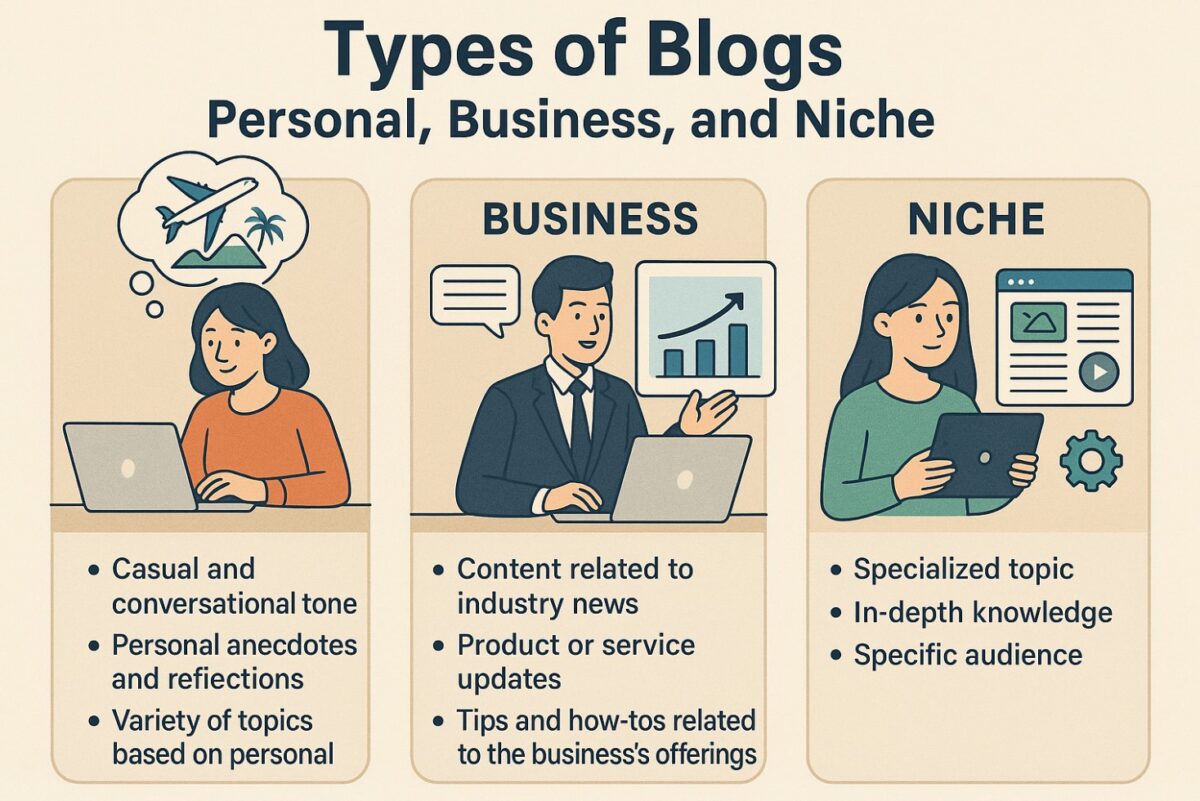
Choosing the right type of blog depends on your goals and passions. Think about what excites you and consider your audience’s needs. Understanding these factors will help create content that resonates and builds a loyal readership. Embrace the diversity of blogging and find your unique voice within the vast blogging world.
How Blogs Work: Structure and Key Features
Understanding how blogs function is crucial before starting one. Blogs are typically structured with a few key components. These elements help organize content and improve user experience. A well-structured blog keeps readers engaged and returning for more.
At the core, every blog features a series of posts. These are articles or entries arranged in reverse chronological order. The most recent post appears at the top, making it easy for readers to find new content.
Blogs also include categories and tags to organize content by topics. This aids navigation and allows readers to find related posts quickly. Categories serve as broad topics, while tags are more specific.
Essential elements of blog posts include:
- A captivating title
- Engaging body text
- Relevant images and media
Additional features enhance a blog’s functionality. Archives allow readers to access older posts, while comments enable interaction. Readers can share their thoughts, creating a sense of community.
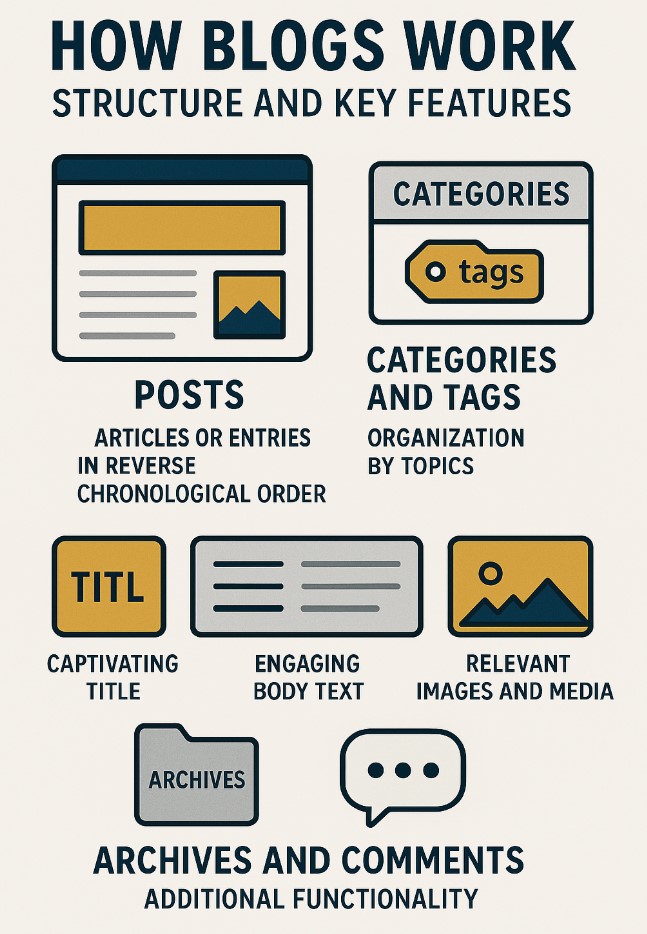
Another integral aspect is an “About” page. This section provides information about the blogger and the blog’s purpose. It builds trust with readers and encourages connection.
Setting up a functional and navigable blog is the foundation of a successful blogging journey. These features will support content discovery and foster audience engagement.
Why Start a Blog? Benefits for Individuals and Businesses
Starting a blog offers various advantages, both personal and professional. It’s a platform to express thoughts and share knowledge. For individuals, blogging can be a fulfilling creative outlet. It allows bloggers to explore topics they’re passionate about.
Businesses use blogs to increase brand visibility and connect with customers. A well-maintained blog establishes credibility and authority within an industry. By providing valuable content, businesses can attract new clients and retain existing ones.
Blogging enhances one’s writing skills and encourages continuous learning. It requires research, analysis, and effective communication. These skills benefit personal growth and professional development.
Blogging also offers networking opportunities. Engaging with readers and other bloggers builds a community. This can lead to collaborations and partnerships, expanding one’s influence.
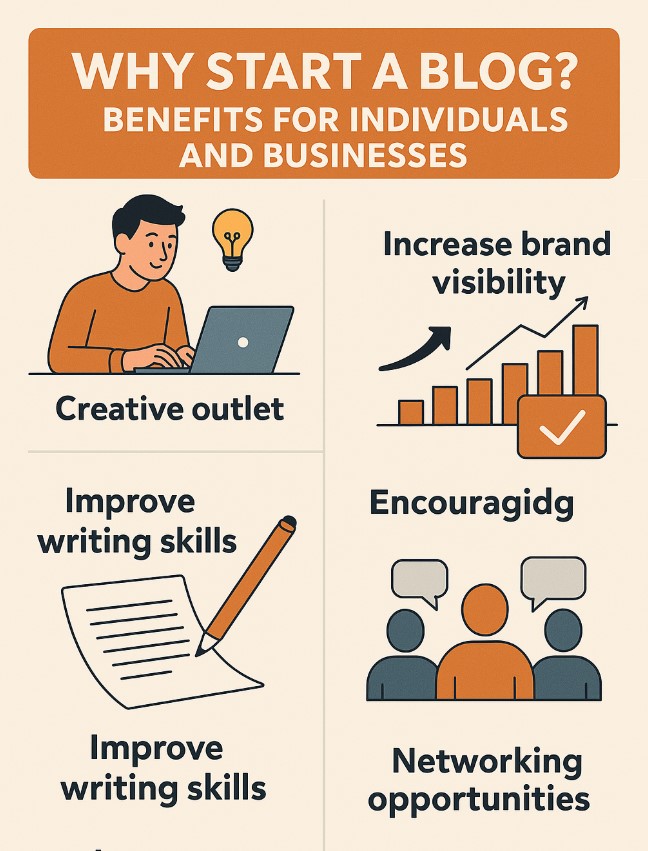
Moreover, blogging is a cost-effective marketing strategy. It drives traffic to websites and improves search engine rankings. Sharing insightful content consistently attracts organic visitors.
Key benefits include:
- Expressing creativity
- Boosting brand recognition
- Gaining new skills
In summary, blogging can significantly impact both individuals and businesses. It opens doors to new opportunities and fosters growth. Whether for personal satisfaction or professional goals, blogging is a worthwhile endeavor.
Step-by-Step Guide to Starting a Blog
Starting a blog may feel overwhelming, but with the right steps, it becomes manageable. First, define your blog’s purpose. Are you sharing personal stories, or are you creating content for a business?
Once you know your purpose, you can move on to identifying your target audience. Knowing your audience informs your content choices. It also guides your promotion strategies.
Next, choose a blogging platform. Popular options include WordPress, Blogger, and Medium. Evaluate their features to find what fits your needs.
Purchasing a domain name is the next logical step. Your domain should reflect your blog’s brand or niche.
Secure a reliable hosting service to make your blog accessible online. Hosting affects your site’s speed and reliability.
Designing your blog involves selecting a theme and customizing it. Make sure your blog’s design is user-friendly and represents your brand.
Create engaging and informative content to attract readers. Consistency in posting improves your blog’s visibility.
Promotion is vital for reaching a broader audience. Use social media and email marketing to share your content.
Finally, monetize your blog for potential income. Explore options like affiliate marketing or selling digital products.
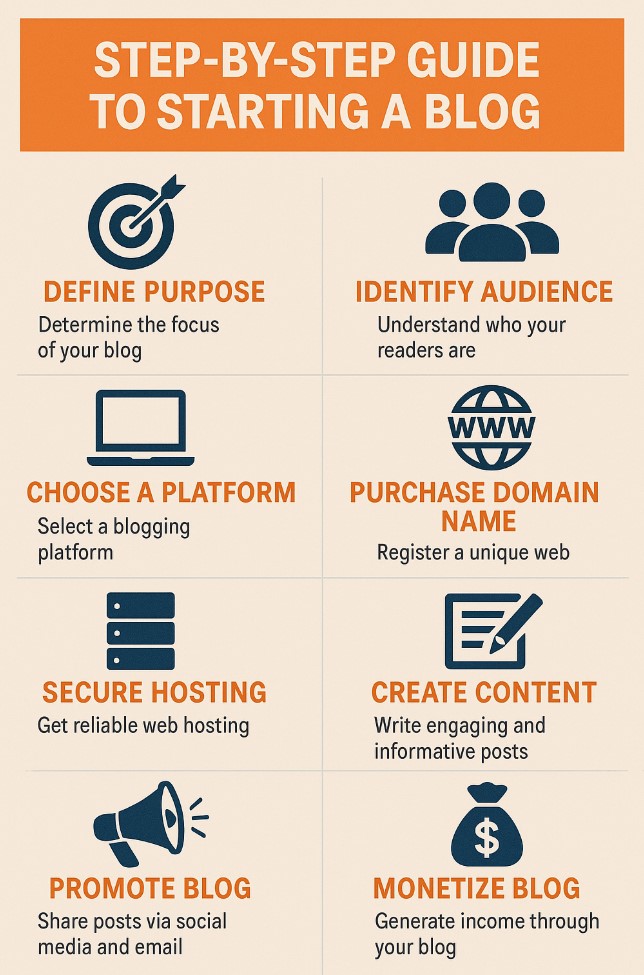
By following these steps, you set the foundation for a successful blog. Continuously update and improve your blog to keep it engaging and relevant.
Choosing Your Niche and Target Audience
Selecting a niche is crucial when starting a blog. Your niche should align with your interests and expertise. It should also have a sizable audience.
Knowing what engages your target audience is key. Identify what challenges they face and what solutions they seek.
A clear niche positions your blog within a specific community. It helps your content stand out among many voices.
Consider these tips for choosing a niche:
- Assess your passions
- Evaluate market trends
- Research competition
Understanding your audience’s needs guides your content strategy. Tailored content creates a loyal readership and can boost your blog’s growth.
Selecting a Blogging Platform and Domain Name
Choosing a blogging platform is an important decision. It impacts your blog’s flexibility and growth. For beginners, WordPress is highly recommended due to its versatility and user-friendly nature.
Blogger and Medium are other viable options, each offering different advantages. Make your choice based on ease of use, customization options, and scalability.
After selecting a platform, you’ll need a domain name. A good domain name is short, memorable, and relevant to your niche.
Consider these points when picking a domain name:
- Keep it simple and easy to spell
- Avoid numbers and hyphens
- Ensure it’s unique
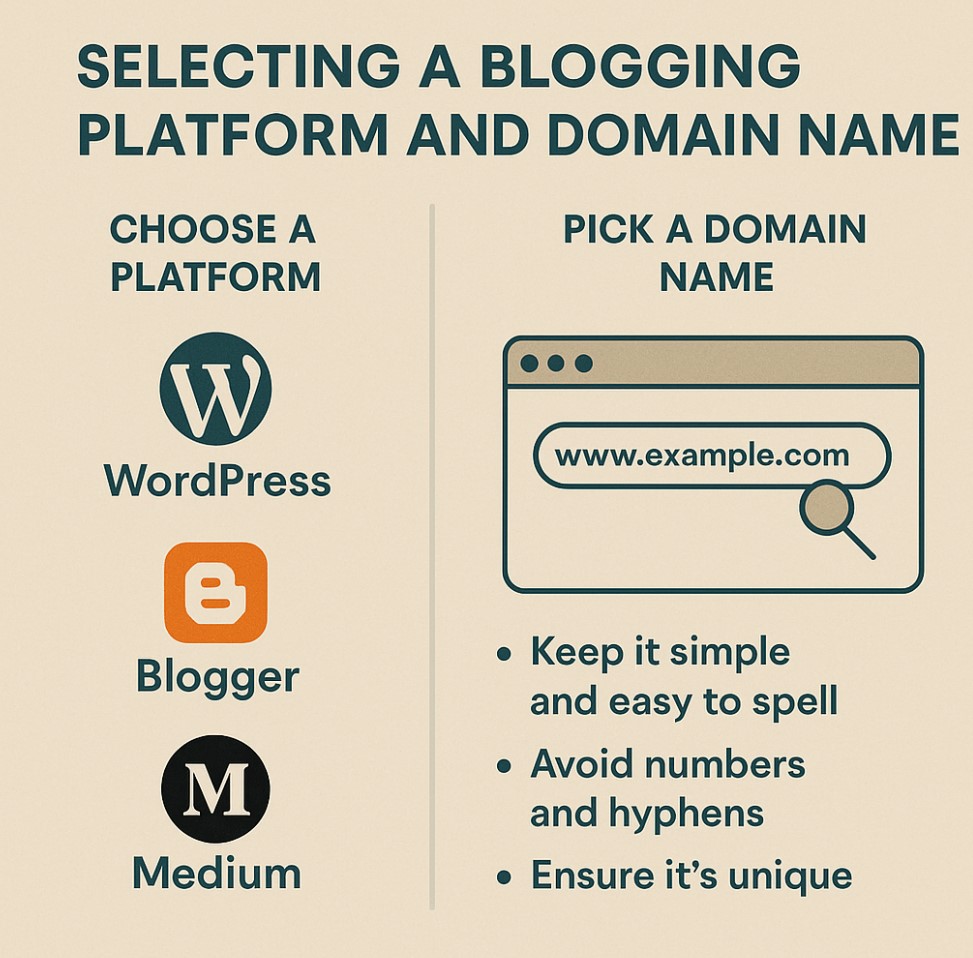
Your domain is integral to your blog’s identity. Choose wisely to ensure it resonates with your audience.
Setting Up Hosting and Designing Your Blog
The next step is setting up hosting for your blog. A hosting service stores your blog online, ensuring it’s accessible to visitors. Popular providers include Bluehost, SiteGround, and HostGator.
When choosing a hosting service, consider reliability, speed, and customer support. A good hosting service enhances your blog’s performance.
Designing your blog is more than choosing a theme. It’s about creating an experience. Your design should align with your brand and be intuitive for users.
Consider these design elements:
- Mobile responsiveness
- Easy-to-navigate structure
- Visually appealing graphics
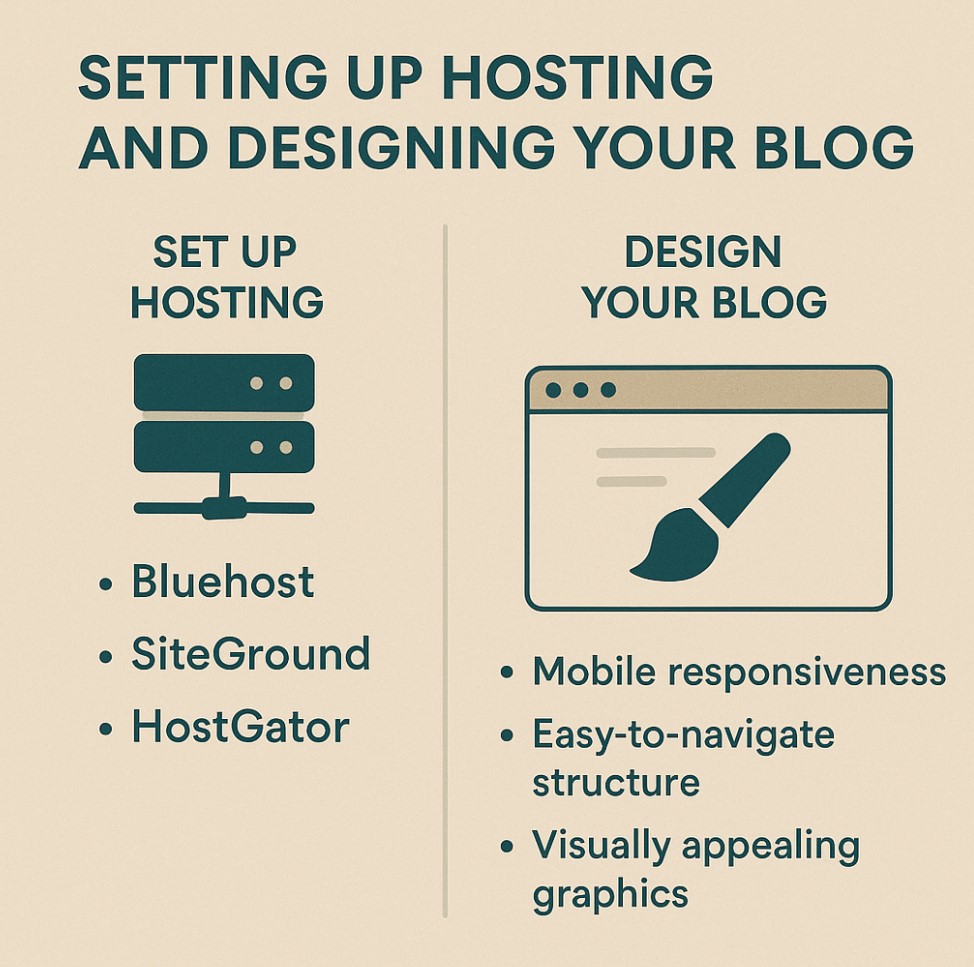
The design of your blog greatly influences reader retention. A visually appealing, easy-to-use blog attracts and retains visitors, encouraging them to explore further.
Creating Great Blog Content: Tips and Strategies
Creating compelling content is at the heart of every successful blog. Quality content captures interest and builds an audience. It establishes your blog’s authority within your niche.
Effective content starts with understanding your audience’s needs. Research what information they’re seeking and the problems they face. Tailor your posts to provide valuable solutions.
Organize your ideas coherently. Aim for a consistent tone and style that suits your brand. This enhances your blog’s readability and user experience.
Incorporate visuals like images, infographics, and videos. They break up text and make information easier to digest. Visuals can also increase engagement.
Here are some strategies to enhance your blog content:
- Use catchy headlines
- Focus on solving problems
- Maintain a conversational tone
Engage your readers by encouraging comments and discussions. Responding to feedback can create a sense of community. It also provides insights into what your audience values.
Regularly updating your content keeps it fresh and relevant. Revisit older posts to ensure they’re accurate and useful. This can improve SEO and attract more visitors.
Utilize lists and bullet points for clarity. They help emphasize important points and make content scannable. Employing these strategies will make your blog both informative and engaging.
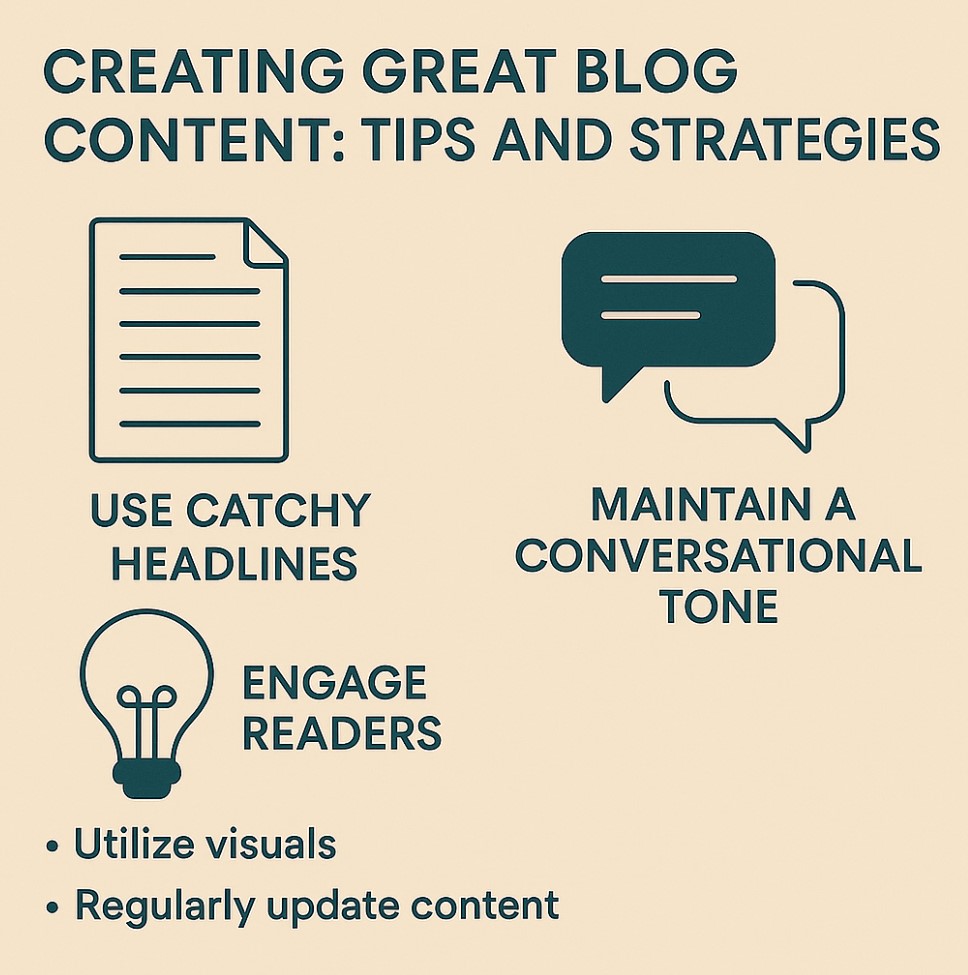
By prioritizing quality and relevance, you’ll foster a loyal readership and boost your blog’s success.
Brainstorming and Planning Blog Posts
Effective brainstorming sparks creativity. Start by listing topics relevant to your niche. Research industry trends and explore what other blogs cover.
Consider these brainstorming techniques:
- Mind mapping
- Brain dumps
- Topic clustering
Once you have a list of topics, prioritize them based on relevance and potential interest. Assess what each topic offers your audience. This helps in planning your content calendar.
Create an outline for each blog post. Outlines organize thoughts and provide direction. They ensure your content remains focused and structured.
Planning ahead allows for consistent posting. It provides time to refine ideas and polish drafts. This not only helps maintain a steady publishing schedule but also enhances content quality.
Writing and Formatting for Engagement
Writing engaging content is essential for retaining your audience. Start with a strong introduction to hook your readers. Present your main ideas clearly and concisely.
Adopt a conversational tone, using simple, direct language. This makes your content more relatable. Break down complex ideas into digestible parts.
Emphasize key points using various formatting techniques:
- Bold text for important statements
- Headings and subheadings for organization
- Bullet points for listing information
Use images to complement your text. Visuals support your message and make it more memorable. They add interest and break up text-heavy sections.
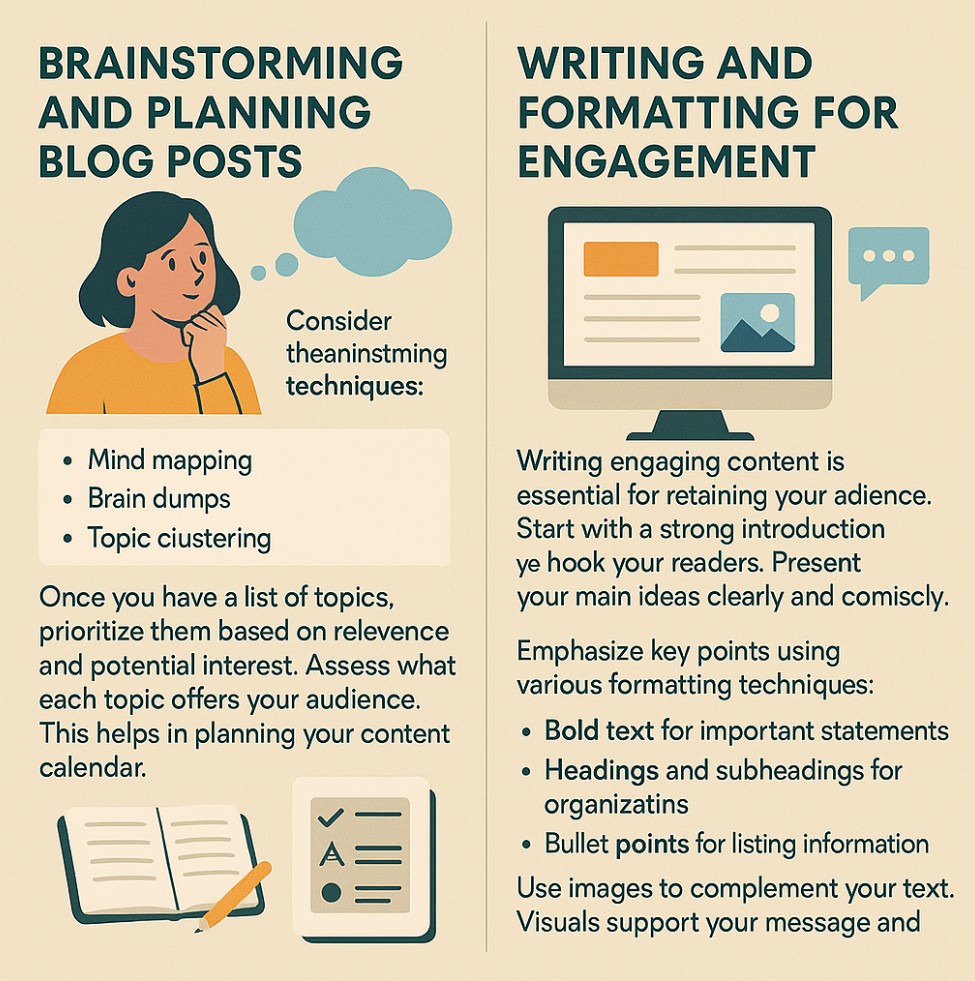
End each post with a clear call-to-action. Encourage readers to leave comments or share your post. Engagement increases your blog’s reach and fosters community. By focusing on these writing and formatting strategies, you’ll create posts that engage and inform your readers.
Promoting Your Blog and Growing Your Audience
Growing your blog audience requires strategic promotion. It’s more than just publishing content; it’s about reaching the right people. Effective promotion can significantly increase your blog’s visibility.
Start by identifying where your audience spends their time online. Tailor your promotion efforts to those platforms. This targeted approach ensures your efforts are efficient.
Use social media to share your blog content. Platforms like Facebook, Twitter, and Instagram can expand your reach. Create visually appealing posts that entice users to click.
Leverage email marketing to keep your audience engaged. Send regular newsletters featuring your latest posts. This keeps your blog top-of-mind for subscribers.
Collaborate with other bloggers to cross-promote content. Guest blogging on popular sites can also introduce your blog to new audiences. These partnerships can accelerate your blog’s growth.
In addition, consider these promotion tactics:
- Participate in online forums
- Engage with readers in the comments
- Offer freebies or incentives for shares
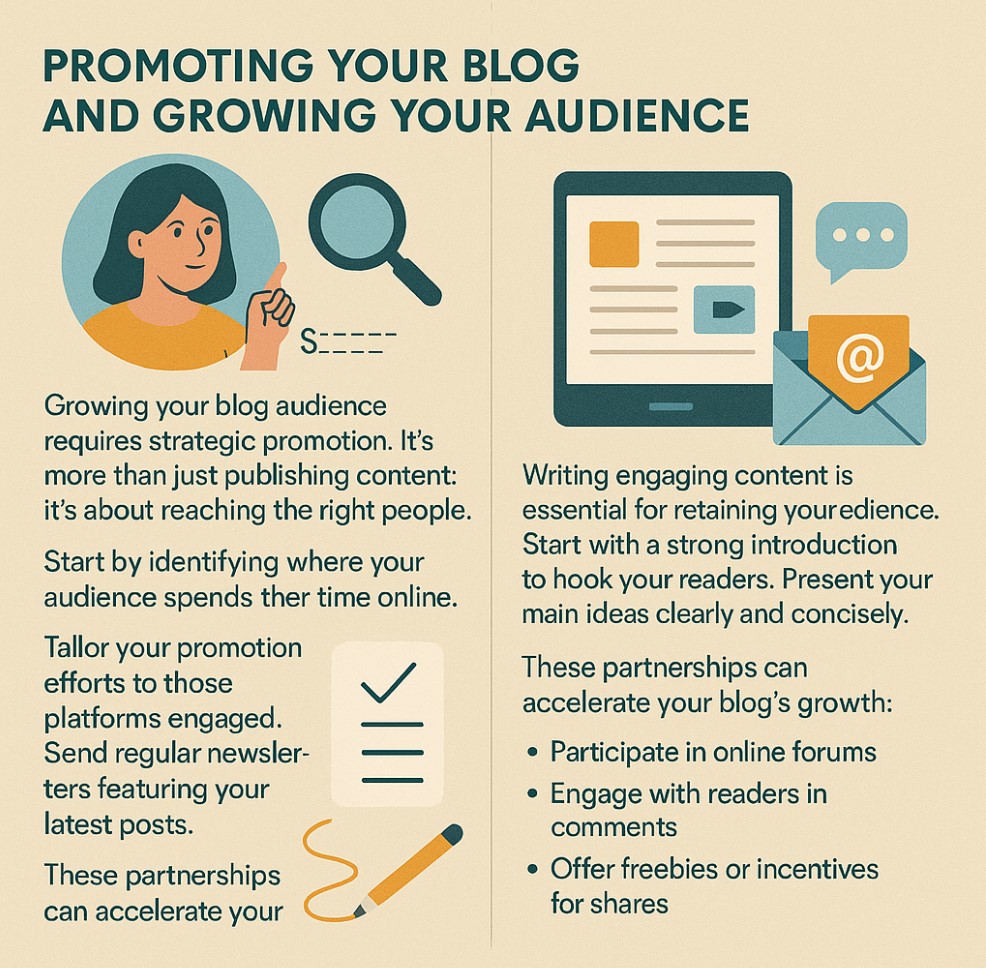
Remember, consistency in promotion is key. Regular engagement with your audience nurtures relationships. Over time, these efforts build a loyal readership and sustainable blog growth.
Leveraging Social Media and Email Marketing
Social media is a powerful tool for blog promotion. Begin by sharing content on platforms frequented by your audience. Customize your messages for each platform to enhance engagement.
Here are some social media tips:
- Use hashtags for discoverability
- Post consistently, maintaining a steady presence
- Create engaging visuals to attract attention
Email marketing helps maintain a close connection with your audience. Building a subscriber list is crucial. Offer valuable content in exchange for an email subscription, such as a free eBook.
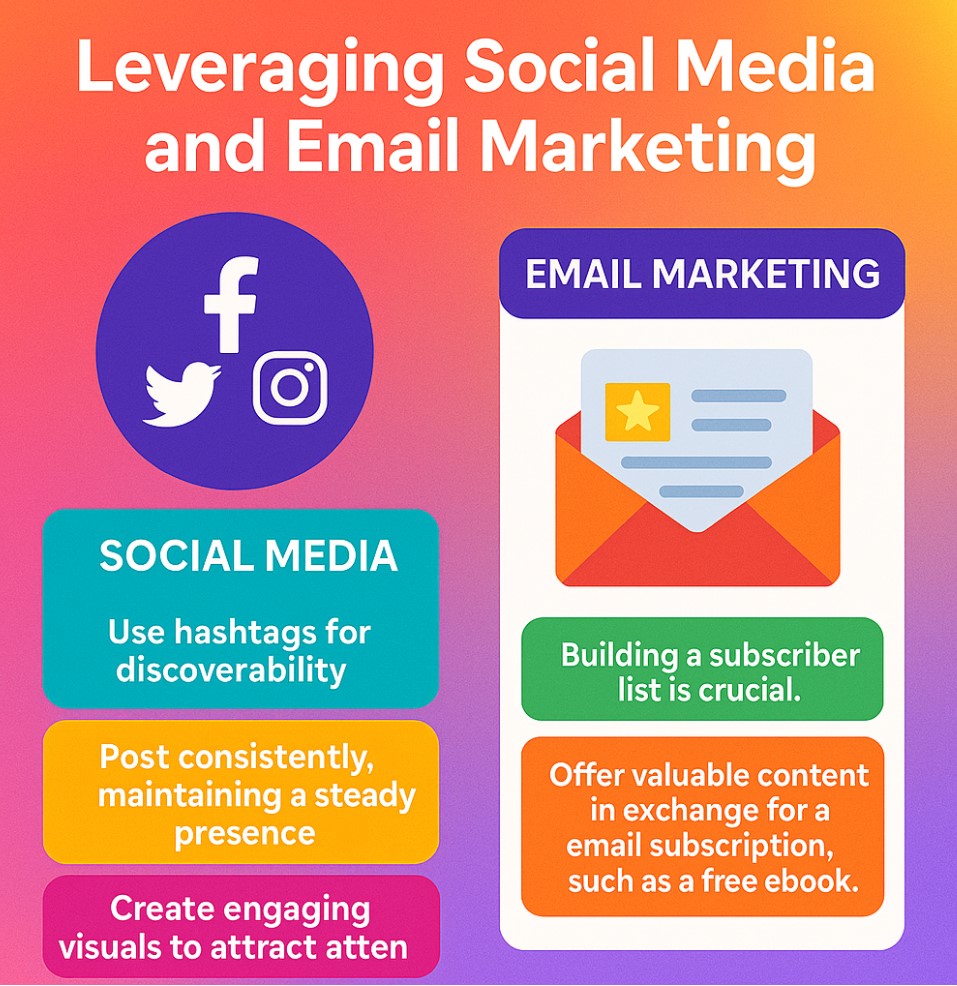
Regular newsletters can keep your subscribers informed. Highlight your newest posts and invite feedback. This involvement can deepen their connection to your blog.
By harnessing social media and email marketing, you’ll foster a robust and engaged community around your blog.
Building Community and Networking with Other Bloggers
Building a community enhances your blog’s growth. Engaging with readers can foster loyalty and return visits. Creating a welcoming space encourages interaction and connection.
Respond promptly to comments and questions from readers. This shows you value their input and can increase engagement. Active participation helps grow a supportive blog environment.
Networking with other bloggers is valuable. Collaborations, such as co-hosted webinars or joint campaigns, can expand your audience. It opens opportunities for shared learnings and mutual promotion.
Consider these networking strategies:
- Participate in blogging groups or forums
- Attend online and offline blogging events
- Engage with influencers in your niche
Collaboration can introduce new perspectives and ideas to your blog. It strengthens your presence within the blogging community. Building these relationships can lead to fruitful opportunities for your blog’s advancement. Another way to gain traffic to your blog is to purchase traffic. You can always buy website traffic from PlugRush!
SEO for Blogs: Getting Found Online
SEO, or Search Engine Optimization, is pivotal for increasing a blog’s visibility. By optimizing content, you can attract more organic traffic. Understanding how search engines rank content is essential.
Keywords play a fundamental role in SEO. Incorporate relevant keywords naturally into your blog posts. This helps search engines understand your content’s topic.
Here are some keyword strategies:
- Use long-tail keywords for targeted traffic
- Analyze keyword trends to remain current
- Balance between popular and niche keywords
Meta tags and descriptions also impact SEO. They provide search engines with additional content details. Craft compelling descriptions to improve click-through rates.
Internal linking strengthens SEO by connecting related content. This keeps readers engaged longer and signals content value to search engines. Organize your content logically for better navigation.
Consider these additional SEO tips:
- Optimize images with alt text
- Maintain fast loading times for better user experience
- Ensure your site is mobile-friendly
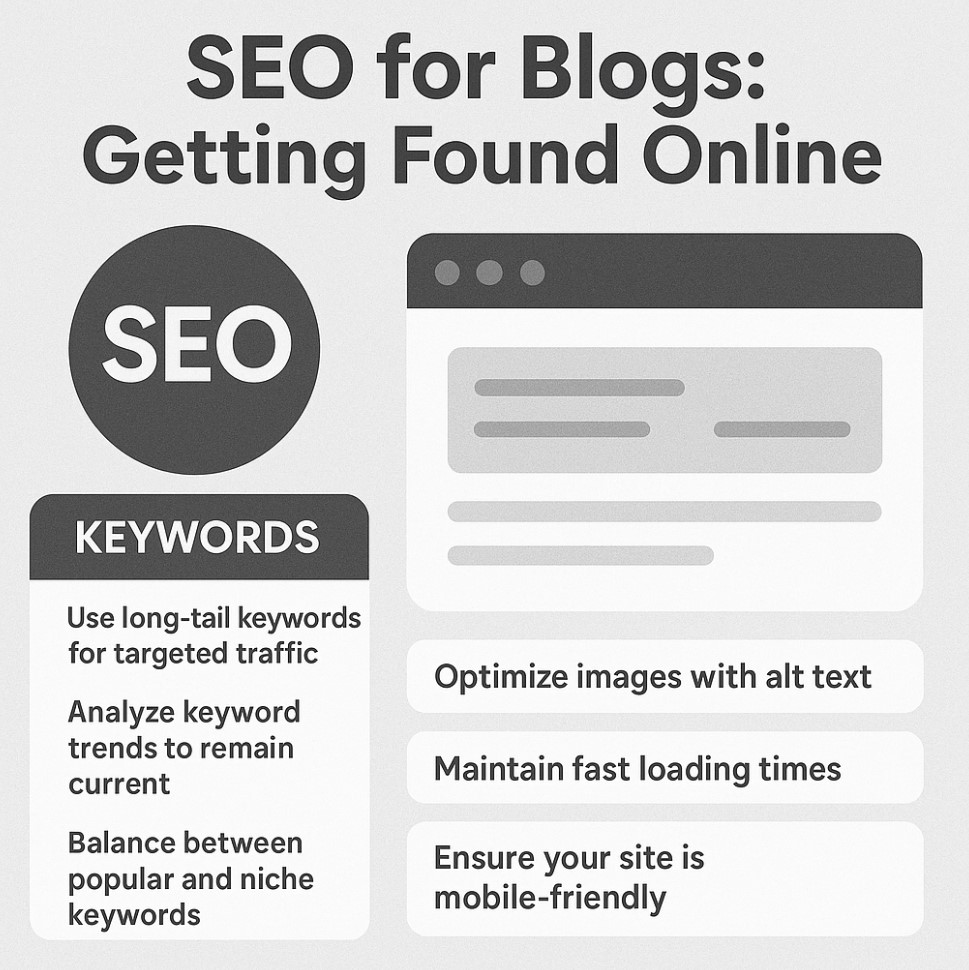
Regularly updating your content can boost SEO rankings. Fresh and relevant content meets users’ ongoing needs. Employ analytics to track SEO performance and refine strategies.
Overall, effective SEO practices can significantly enhance your blog’s online presence. By optimizing your content, you make your blog more accessible to a broader audience.
How to Make Money by Blogging: Monetization Methods
Turning your blog into a source of income is attainable. Numerous methods can help you earn money by blogging effectively.
One popular method is affiliate marketing. By promoting products and earning commissions on sales, bloggers can benefit financially. Choose products relevant to your niche for authenticity. Another way to earn money is by using display advertising, such as banners, native ads and other display ads. But, what network do you use for this? Choosing the right ad network is crucial, so how do you choose the right ad network?
Consider sponsored posts as another revenue stream. Companies may pay for posts featuring their products or services. Ensure these partnerships align with your brand and values.
Digital products offer lucrative opportunities. E-books, printables, and courses can generate passive income. These products have minimal ongoing costs, making them profitable over time.
Here’s a look at common monetization methods:
- Affiliate marketing
- Sponsored content
- Display Ads such as Banners and Popunders
- Selling digital products
Membership sites provide access to exclusive content for a fee. Loyal readers willing to support your work can contribute steady income.
Ad placements also present financial opportunities. Platforms like Google AdSense enable revenue through ads shown on your blog. However, balance ads to avoid cluttering your site.
Explore these additional methods:
- Subscription services
- Offering consulting or coaching
- Hosting webinars
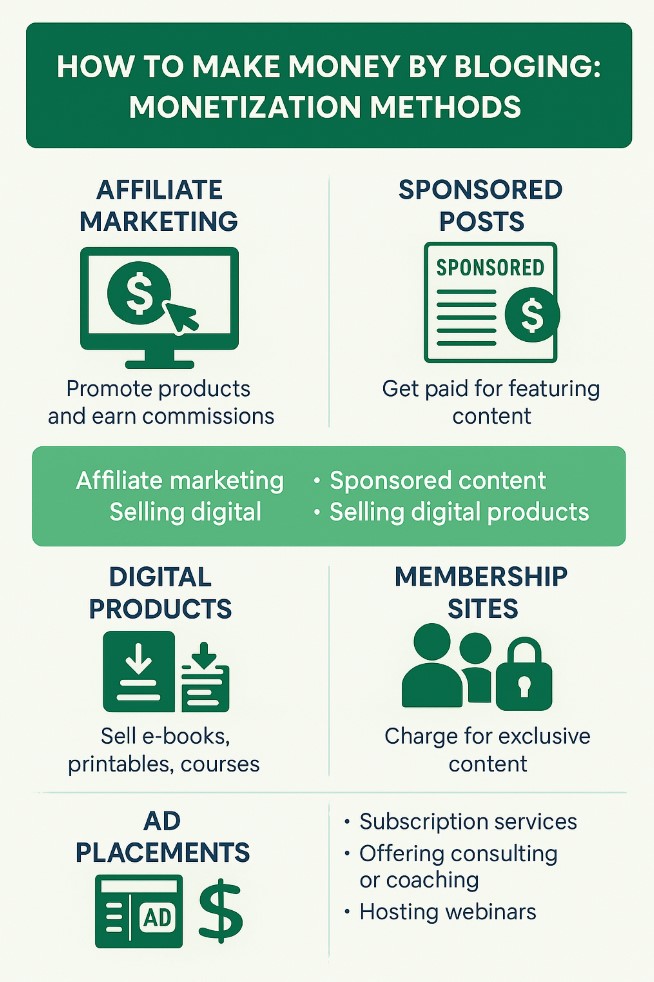
Building a strong brand is essential for monetization success. With consistency and a clear value proposition, you can cultivate a supportive audience. This foundation enables ongoing revenue growth.
Passive Income Ideas for Bloggers
Generating passive income is a goal for many bloggers. With upfront effort, revenue can flow with minimal ongoing work.
Affiliate marketing remains a solid passive income choice. By embedding affiliate links in evergreen content, earnings can accumulate over time. Focus on quality content to maximize affiliate potential.
Creating online courses is another passive option. Initial effort involves course development, but consistent sales can follow. Offer self-paced courses to appeal to busy readers.
Explore further passive income strategies:
- Create and sell e-books
- Offer membership content
- Develop niche subscription services
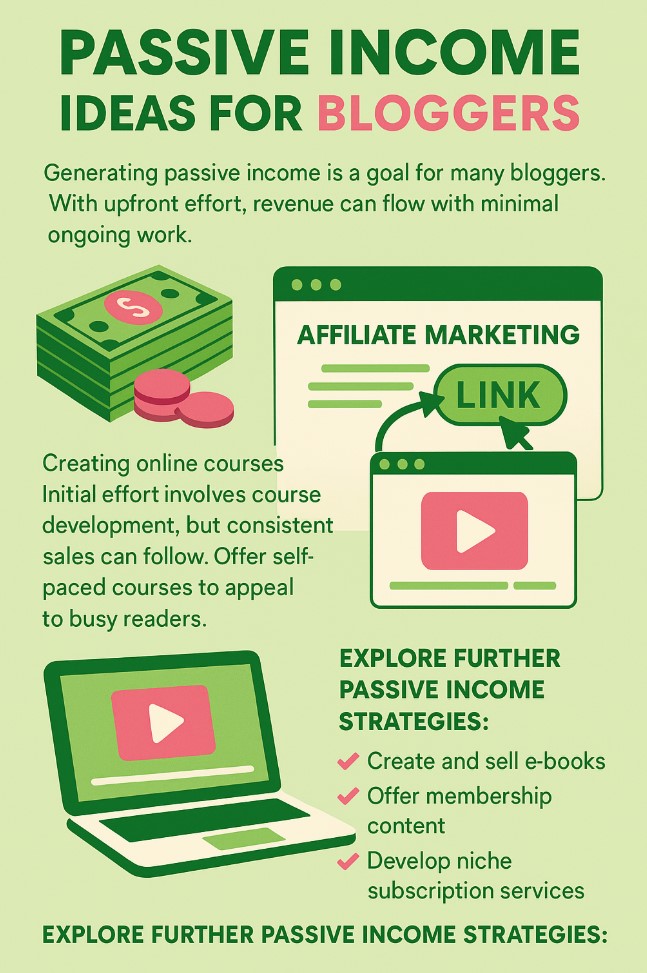
Ultimately, diversification is key to sustaining passive income. By employing various strategies, you enhance financial stability.
Diversifying Your Online Income: YouTube, Courses, and More
Expanding beyond your blog can boost income. Leveraging other platforms broadens your reach and revenue avenues.
YouTube is a popular option for bloggers. Video content complements written posts, engaging audiences differently. Monetize through ads, sponsorships, and merchandise.
Consider developing online courses. They allow you to dive deeper into topics and offer valuable learning experiences. Courses can command premium pricing for substantial profits.
Consider diverse online income avenues:
- Create a YouTube channel
- Develop online courses
- Sell merchandise related to your blog
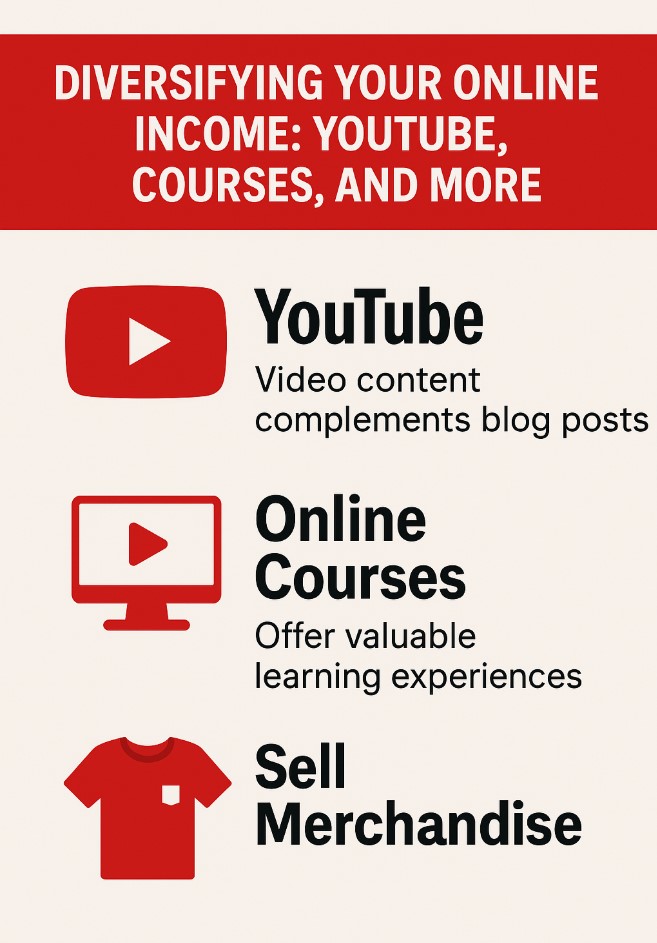
Implementing multiple income streams mitigates risk. Should one avenue fluctuate, others can stabilize overall earnings. Diversification strengthens financial resilience over time.
Common Challenges and How to Overcome Them
Blogging presents several hurdles that new and seasoned bloggers often face. These challenges, however, can be mitigated with strategic approaches.
One common issue is finding time for consistent content creation. Balancing blogging with other responsibilities can be tough. Implement a schedule to organize your posting routine effectively.
Another challenge is growing your blog’s audience. Initially, attracting readers might seem slow. Engaging with niche communities and leveraging social media can enhance visibility and growth.
Technical difficulties can also arise, especially for beginners. Learning the basics of blog maintenance, like updates and backups, is crucial. Many platforms offer tutorials, making it easier to improve your skills.
Monetization struggles are prevalent, too. Earnings might not reflect your effort immediately. Patience and experimenting with various monetization strategies can gradually improve financial results.
Here’s how to tackle common blogging challenges:
- Develop a content schedule
- Engage with communities
- Enhance technical skills
- Experiment with monetization strategies
Staying motivated is vital for overcoming blogging challenges. Remember the passion that initiated your journey and use it as fuel to push through hurdles successfully.
Legal, Ethical, and Technical Considerations
Bloggers must navigate several legal and ethical considerations. Addressing these at the outset helps avoid future complications.
Copyright laws protect original content. Always give credit when using others’ work. This applies to images, quotes, and references.
Privacy policies are essential for websites that collect data. They inform visitors about data collection practices. Craft a clear policy to build trust with your audience.
Technical considerations involve site security and maintenance. Regular updates prevent vulnerabilities. Opt for reliable hosting services for optimal performance and security.
Key Considerations for Bloggers
- Respect copyright laws
- Implement a privacy policy
- Ensure regular site updates
- Choose secure hosting options
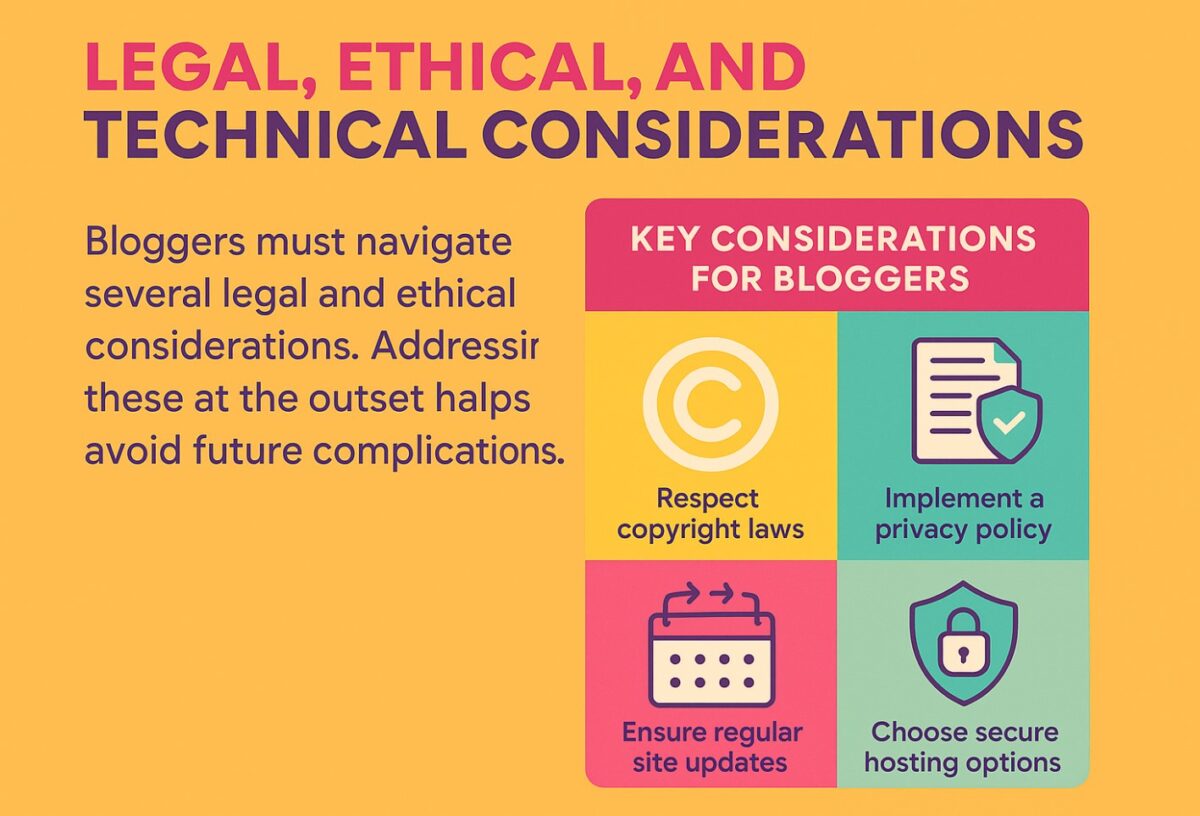
Understanding these aspects enhances your blog’s credibility. Address these factors early to focus on creating quality content and growing your audience without unforeseen issues.
Tracking Your Blog’s Success: Analytics and Improvement
Monitoring your blog’s performance is vital for its growth. Analytics tools provide insights into what works and what doesn’t.
Google Analytics is a popular choice for tracking website data. It reveals page views, bounce rates, and audience demographics. Understanding this information helps refine your content strategy.
Regularly review your blog metrics to identify trends. Patterns in traffic and engagement can guide future content creation. Knowing which posts perform well allows you to focus on similar topics.
Improvement doesn’t happen overnight. Use analytics to set realistic goals and measure progress. Continual assessment ensures your blog aligns with audience interests and expectations.
Key Metrics to Track
- Page views
- Bounce rates
- Audience demographics
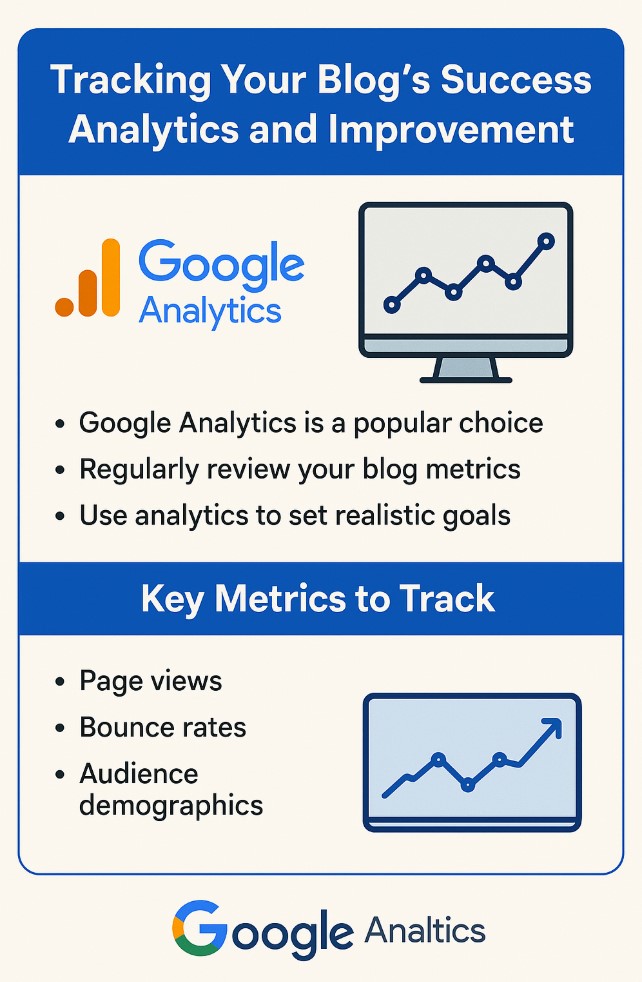
Tracking these metrics is a pathway to informed decisions. They help tailor your strategy for sustained success and reader engagement.
The Future of Blogging: Trends and Opportunities
The blogging landscape is continually evolving. Staying informed about trends can provide a competitive edge.
AI technology is impacting content creation. Tools that assist with writing and SEO are becoming more advanced. Utilizing these can improve efficiency and content quality.
Visual content is gaining importance. Blogs with engaging images and videos attract more readers. Integrating multimedia elements can enhance user experience.
Interactive content is another growing trend. Quizzes, polls, and live videos engage audiences differently. Exploring these formats can diversify your blog’s offerings.
Emerging Trends
- AI-driven content tools
- Visual and multimedia integration
- Interactive content forms
Keeping up with these trends can open new opportunities. They help in reaching broader audiences and improving engagement. Embracing innovation ensures that your blog remains relevant in a dynamic digital world.
Conclusion: Is Blogging Right for You?
Blogging offers diverse opportunities. It can be a personal outlet or a business tool. The potential to reach a global audience is significant.
Consider your goals and interests. Blogging requires dedication and patience. It’s a long-term commitment that can yield rewarding experiences.
If you’re seeking creative expression or wish to grow a business, blogging may be a perfect fit. Evaluate your readiness to invest time and energy. This will help determine if blogging aligns with your aspirations. If it does, embrace the journey ahead.




